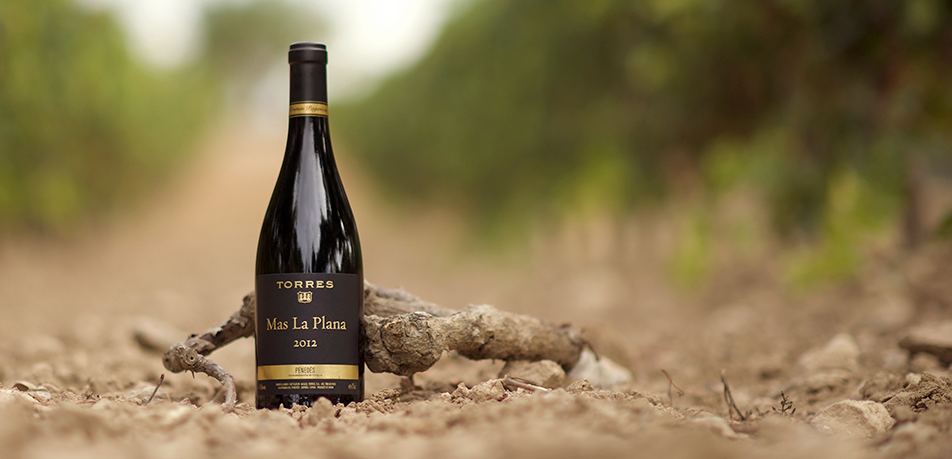Antología Miguel Torres (IV): Mas La Plana

One of the Torres Family's great icons is celebrating its fortieth vintage, but its success belies the initial challenges involved in creating and producing the wine, as well as achieving recognition. This is a story about original ideas, dashed hopes, and finally, a very personal endeavor, a wine that would change everything: Mas La Plana.
A very personal endeavor that changed the wine sector
We should keep in mind the main factors that make Mas La Plana more than a wine. It bears such a personal signature that understanding the wine means understanding the man who created it: Miguel A. Torres. As we've said on previous occasions, any project driven by the determination of a nonconformist tends to stir up controversy. These kinds of creative endeavors transcend their own time and lay the foundations for future growth and development.
Mas La Plana is the result of forty vintages worth of experience, embodying the legacy of a wine whose origins have crossed the threshold from history to legend.
The arrival of Miguel A. Torres on the winemaking scene, first in Spain, then internationally, marked a step forward for the country's quality wines, ushering in an era of modernized winemaking techniques and greater varietal diversity in the Penedès vineyards.
Miguel A. Torres's daring wine moved away from the era's winemaking tradition to give expression to the Cabernet Sauvignon that had been planted at the eponymous estate in 1966.
Paris 1979: a legend is born
In 1979, the top trade magazine Gault & Millau organized the Wine Olympics in Paris. The 1970 vintage of Mas La Plana, its first, beat the most renowned and distinguished Cabernets in the world, a position formerly reserved for France's great châteaux.
[[{"fid":"13484","view_mode":"default","fields":{"format":"default","alignment":"","field_file_image_alt_text[und][0][value]":false,"field_file_image_title_text[und][0][value]":false},"type":"media","field_deltas":{"1":{"format":"default","alignment":"","field_file_image_alt_text[und][0][value]":false,"field_file_image_title_text[und][0][value]":false}},"link_text":null,"attributes":{"height":2362,"width":1713,"style":"height: 689px; width: 500px;","class":"media-element file-default","data-delta":"1"}}]]
Wine Olympics ranking published in the prestigious Gault & Millau magazine.
It was a stunning surprise that put Penedès on the winemaking map. However, this was only the first in a long list of international distinctions that have made Mas La Plana the most universal of all Spanish wines.
[[{"fid":"13485","view_mode":"default","fields":{"format":"default","alignment":"","field_file_image_alt_text[und][0][value]":false,"field_file_image_title_text[und][0][value]":false},"type":"media","field_deltas":{"2":{"format":"default","alignment":"","field_file_image_alt_text[und][0][value]":false,"field_file_image_title_text[und][0][value]":false}},"link_text":null,"attributes":{"height":2362,"width":1181,"style":"height: 1000px; width: 500px;","class":"media-element file-default","data-delta":"2"}}]]
Presentación de Gran Coronas ‘etiqueta negra’, antes de presentarse como Mas La Plana
Mas La Plana: a vineyard where Cabernet Sauvignon feels at home
These 29 hectares under the influence of a Mediterranean climate already produced wine in Roman times and the Middle Ages. Today they are planted with noble Cabernet vines that average 30 years in age and grow in Quaternary soils made up of calcareous silt over fluvial terraces and gravel.
Under these conditions, the row orientation of the grapevines is designed to provide the plants with evenly balanced sun exposure.
[[{"fid":"13486","view_mode":"default","fields":{"format":"default","alignment":"","field_file_image_alt_text[und][0][value]":false,"field_file_image_title_text[und][0][value]":false},"type":"media","field_deltas":{"3":{"format":"default","alignment":"","field_file_image_alt_text[und][0][value]":false,"field_file_image_title_text[und][0][value]":false}},"link_text":null,"attributes":{"height":3311,"width":4961,"style":"height: 334px; width: 500px;","class":"media-element file-default","data-delta":"3"}}]]
Mas La Plana vineyard in Pacs del Penedès.
Furthermore, the planting density is high, forcing the vines to compete for water and nutrients. This results in lower-yielding plants, which produce smaller berries with higher concentration.
The experience gathered over the years allowed the estate and its winery to break new ground and become a leader in winemaking techniques, which the rest of the sector then successfully adopted:
- Limited-production quality wines
- Environmental awareness
- Division of land into parcels
- Suitable clone selection
The variety's clone 15 was chosen, because it produces grapes that are rich in sugars and pigments and have excellent, ripe, fruit tannins.
Mas La Plana: The Wine
Although every vintage reveals small differences, the wine stays true to a particular paradigm that defines the identity of this wonderfully deep Cabernet.
Until the moment of uncorking, the soul of the terroir slumbers in the bottle. The wine's expression and structure point to its origin, which is unmistakably present in the quality and richness of its fleshy, fruity tannins. It comes across in the intense varietal notes of the vineyard's microclimate, offering up a deep and fascinating nose of Mediterranean forest, blueberries and blackberries.
[[{"fid":"13488","view_mode":"default","fields":{"format":"default","alignment":"","field_file_image_alt_text[und][0][value]":false,"field_file_image_title_text[und][0][value]":false},"type":"media","field_deltas":{"4":{"format":"default","alignment":"","field_file_image_alt_text[und][0][value]":false,"field_file_image_title_text[und][0][value]":false}},"link_text":null,"attributes":{"height":5751,"width":8040,"style":"height: 358px; width: 500px;","class":"media-element file-default","data-delta":"4"}}]]
Bottle of Mas La Plana amid its characteristic soil.
Aging in French oak for 18 months rounds out and refines the quality of the tannins, giving the wine a delightful and characteristic maturity that is expressed in echoes of spices, chocolate and coffee.
The ripe, fruity tannins return on the long midpalate, enveloped in mouthfilling layers of velvet. The depth and volume display seamless elegance, unfolding organically and naturally on the palate.
Mas La Plana represents a paradigm shift that ended the international ostracism of Spanish wines. It marked a turning point that might still be too recent to properly realize the importance of Miguel A. Torres's winemaking work.
